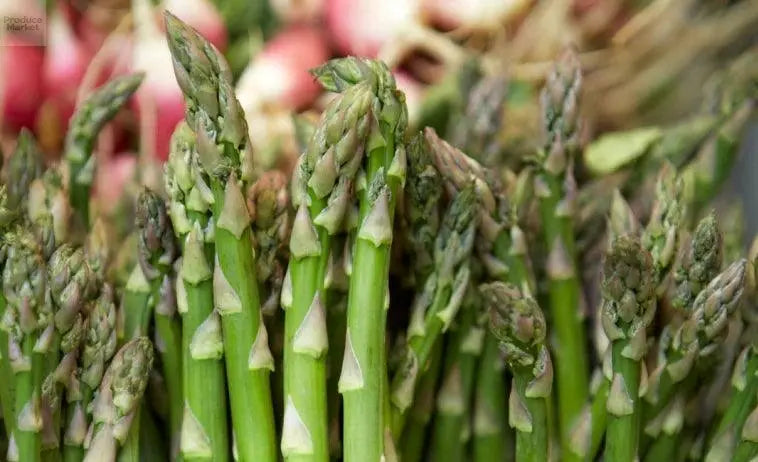
The Best Roasted Asparagus: A Simple and Delicious Side Dish
Share
Best Roasted Asparagus Recipe for a Simple Side Dish
Want to make perfect roasted asparagus? We’ve got you covered. Learn how to select, season, and roast asparagus for a delicious side dish.
Asparagus is at its peak during asparagus season, which runs from April to June, making it an ideal time to enjoy this vegetable.
Introduction to Asparagus
Asparagus is a popular and nutritious vegetable that can be cooked in a variety of ways, including roasting. Roasting asparagus brings out its natural sweetness and flavor, making it a perfect spring side dish. To cook asparagus, simply trim the woody ends, toss with olive oil, salt, and pepper, and roast in a hot oven. Fresh lemon juice can be added to enhance the flavor. Asparagus recipes are versatile and can be customized with various seasonings, such as garlic powder, parmesan cheese, and balsamic vinegar.
Key Takeaways
-
Roasting asparagus is simple and requires just a few key ingredients: fresh asparagus, olive oil, kosher salt, black pepper, garlic powder, and Parmesan cheese.
-
Preparation is key: rinse and dry the asparagus, trim the woody ends, and choose thicker stalks for even cooking.
-
Roast asparagus in a preheated oven at 425°F for 12-15 minutes, and enhance the flavor with lemon juice, balsamic vinegar, and fresh herbs after roasting.
Ingredients for Roasted Asparagus
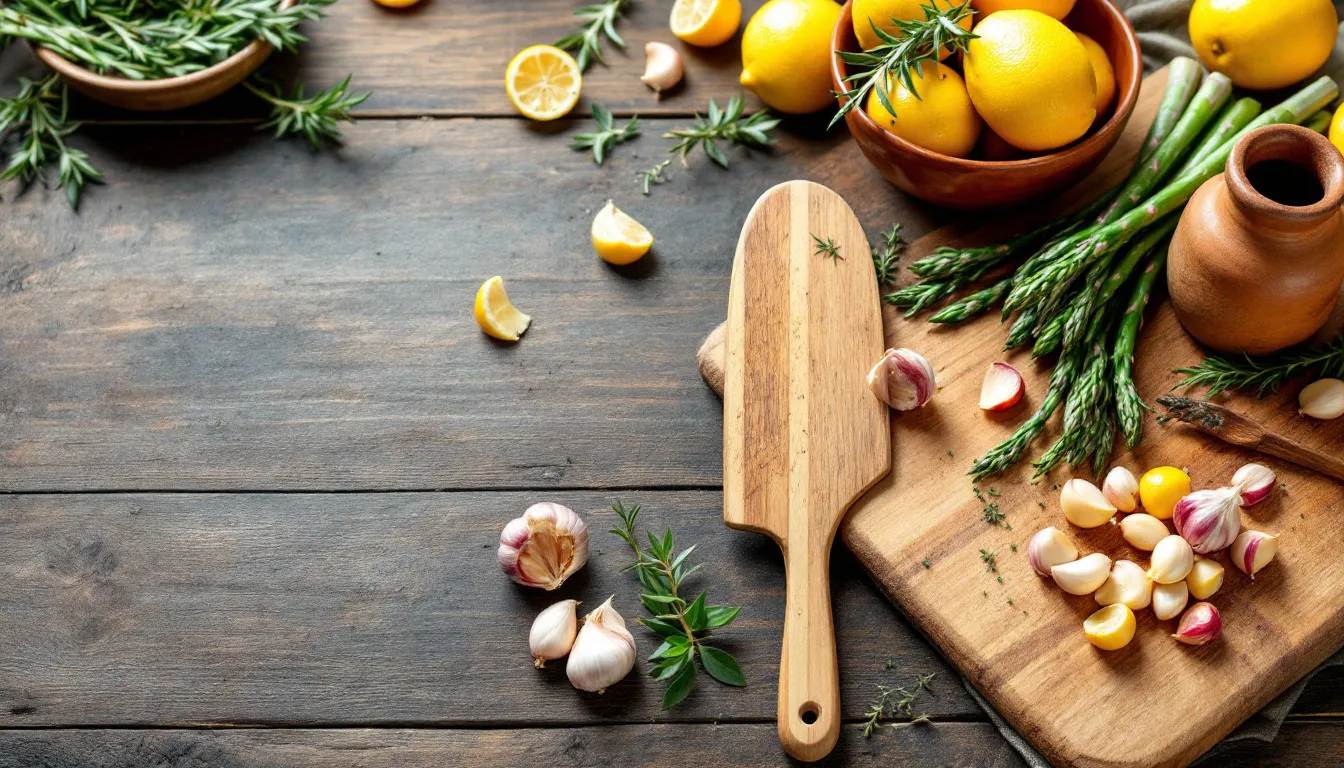
The beauty of this roasted asparagus recipe lies in its simplicity. You’ll need just a handful of ingredients, each playing a crucial role in enhancing the natural flavors of the asparagus. The stars of the show are, of course, the asparagus spears. Fresh asparagus is a must; look for bright green stalks with tightly closed tips.
Here is the text with the incorporated keyword:
“With the arrival of warmer weather, many people look forward to outdoor activities that make the most of the perfect spring season.”
You’ll also need olive oil, kosher salt, freshly ground black pepper, garlic powder, and freshly grated Parmesan cheese. Olive oil ensures even roasting and a beautiful caramelized finish. Kosher salt and black pepper offer basic seasoning, with garlic powder adding a subtle depth of flavor. A finishing touch of freshly grated Parmesan cheese takes this dish to a whole new level of deliciousness.
For an extra burst of flavor, consider using fresh garlic. Additionally, olive oil spray can be used as an alternative to regular olive oil for seasoning the asparagus.
After: Naturally snap
You’ll also need:
-
Olive oil, which ensures even roasting and a beautiful caramelized finish
-
Kosher salt and freshly ground black pepper, which offer basic seasoning
-
Garlic powder, which adds a subtle depth of flavor
-
Freshly grated Parmesan cheese, which takes this dish to a whole new level of deliciousness
Preparing Asparagus for Roasting
Proper preparation is crucial before cooking asparagus. Start by rinsing the asparagus spears under cold water to remove any dirt or grit. Pat them dry with a clean kitchen towel to ensure they roast evenly without steaming. Placing the asparagus cut ends in a drinking glass filled with water can help keep them fresh.
Next, trim asparagus by removing the tough, woody ends of the asparagus. You can do this by aligning the stalks and cutting off the thick ends with a sharp knife or by snapping them off individually. The asparagus will naturally break at the fibrous part, ensuring you only use the tender portion.
Thicker asparagus is preferred for roasting as it cooks more evenly and retains a pleasant texture. However, if you have very thin asparagus, adjust the cooking time accordingly to prevent them from becoming too crispy.
Now that your asparagus is prepped, let’s prepare asparagus for seasoning. Covering the asparagus with a plastic bag or wrap can help retain moisture when storing in the refrigerator.
Seasoning Asparagus
Seasoning is where you can truly make roasted asparagus your own. Season asparagus by drizzling the spears with olive oil and sprinkling them with kosher salt and freshly ground black pepper. This simple combination brings out the natural flavors without overpowering them.
For added zest, try a squeeze of fresh lemon juice and a sprinkle of lemon zest. A little lemon juice can be added after roasting to enhance the flavor. Garlic lovers might want to include minced garlic or garlic powder for an extra kick. Red pepper flakes can also be added for a hint of heat.
Use a large bowl to toss the spears with olive oil and seasonings for even coverage. This method ensures each spear is uniformly coated, leading to consistent flavor and roasting. Now that your asparagus is perfectly seasoned, it’s time to roast it in the oven.
How to Roast Asparagus in the Oven
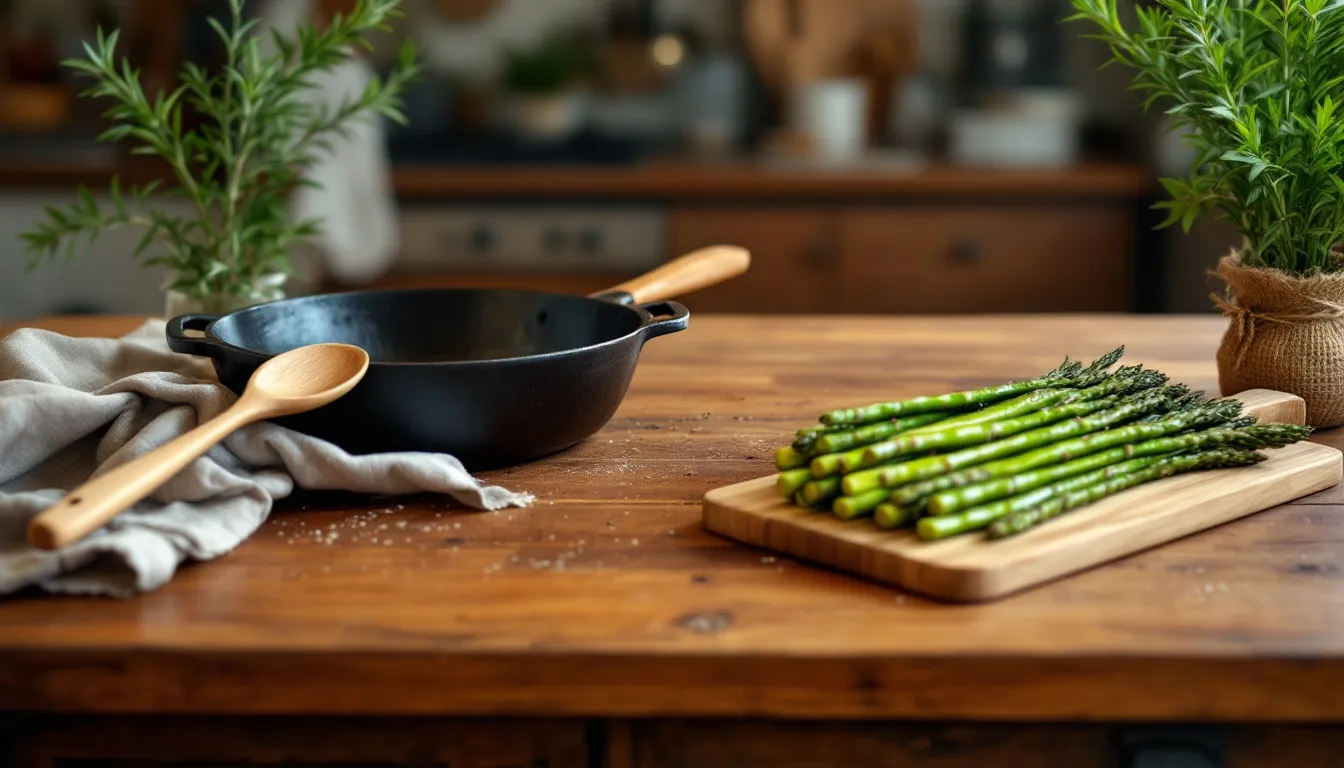
Preheat the oven to 400°F to ensure a hot oven ready for roasting in a preheated oven. While the oven heats, arrange the seasoned asparagus spears on a rimmed baking sheet. Spread the spears in a single layer to ensure even cooking. Lining the baking sheet with parchment paper can make clean-up easier and prevent sticking.
Thicker asparagus stalks may require up to 20 minutes to roast, while thinner ones might only need about 12 to 18 minutes. Keep an eye on them to avoid overcooking. The goal is to achieve tender yet slightly crisp asparagus with a bit of caramelized browning. The residual oil and asparagus juices on the baking tray contribute to the flavor.
Remember, roasting asparagus in the oven is a versatile way to cook asparagus. You can adjust the temperature and time slightly based on your preference and the thickness of the asparagus spears. Now, let’s delve into the specifics of how to bake asparagus, including baking time and temperature.
Baking Time and Temperature
Set your oven to 425°F for perfectly roasted asparagus. This temperature ensures the asparagus cooks evenly, developing a tender interior with a slightly crisp exterior. Thick spears are preferred for roasting as they retain moisture better and develop a tender interior with a slightly crisp exterior.
Roasting time ranges from 12 to 15 minutes, depending on the thickness of the spears. Thicker asparagus may take closer to 15 minutes, while thinner spears might be done in around 12 minutes. Check for tenderness by piercing the thickest part of the spear with a fork.
Using a rimmed baking sheet or a sheet pan ensures the asparagus roasts in a single layer, promoting even cooking and browning. Once your asparagus is roasted to perfection, it’s time to enhance its flavor further.
Air Fryer Alternative
For a crispy and healthier alternative to oven-roasted asparagus, try using an air fryer. Simply trim the asparagus spears, toss with olive oil, salt, and pepper, and cook in the air fryer at 400°F (200°C) for 5-7 minutes. This method produces a delicious and tender asparagus dish with much less oil than deep-frying. Thicker asparagus spears may require a few more minutes of cooking time. Freshly ground black pepper and a squeeze of lemon juice can be added to taste.
Enhancing Flavor After Roasting
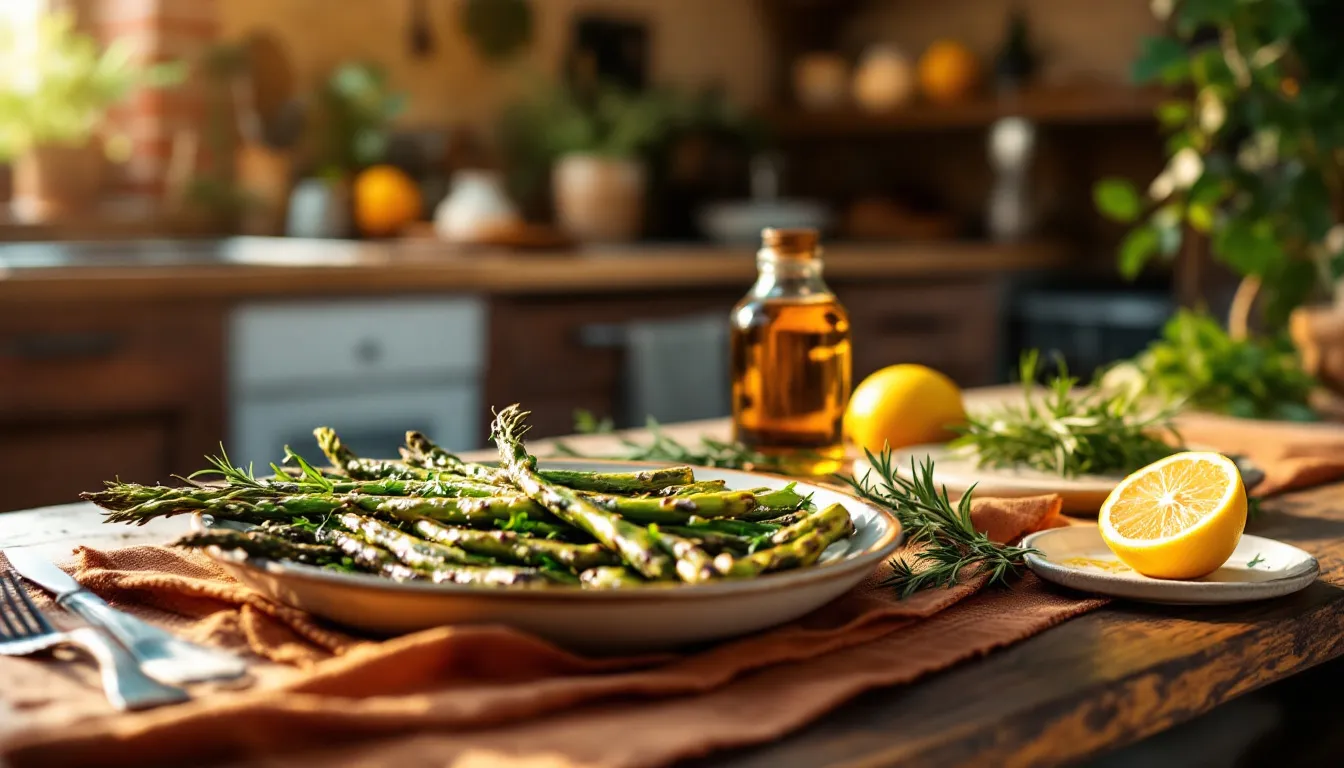
Enhancing the flavor after roasting can elevate the dish from great to absolutely delicious. A squeeze of fresh lemon juice brightens the taste lemon juice, complementing the natural flavors of the asparagus, which adds so much flavor.
Adding a drizzle of balsamic vinegar or balsamic glaze can introduce a tangy depth, balancing the savory notes. For a rich and savory finish, sprinkle freshly grated Parmesan cheese over the warm asparagus.
Don’t forget to add a light sprinkle of sea salt and freshly ground black pepper to enhance the overall flavor profile. Chopping and sprinkling fresh herbs like parsley or mint on top adds freshness and a pop of color.
Now that your asparagus is perfectly seasoned and roasted, let’s discuss how to serve this delightful dish on a serving platter.
Serving Suggestions
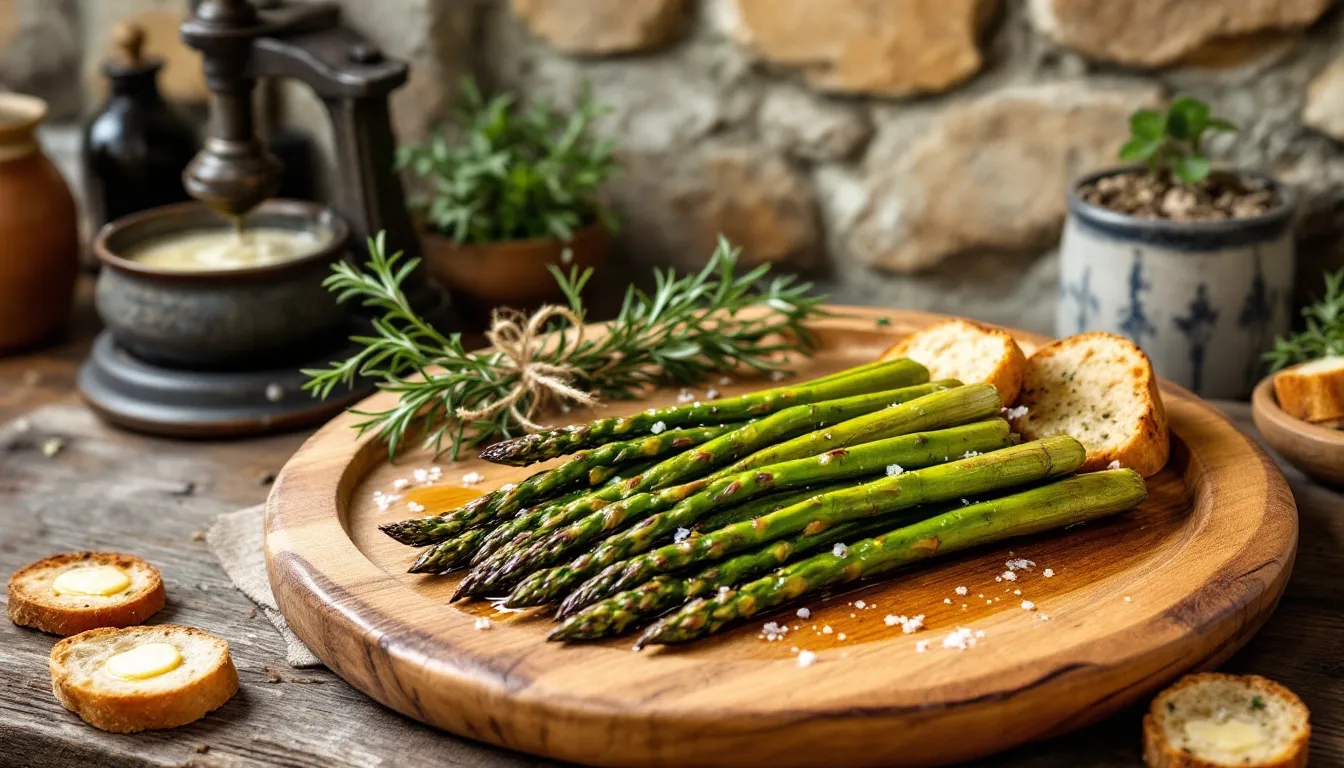
This versatile perfect spring side dish pairs beautifully with a variety of main courses. It complements proteins like lamb, chicken, grilled fish, steak, and pork. Additionally, you can serve it alongside grains like quinoa or rice for a balanced meal.
For a refreshing twist, try making an asparagus and cucumber salad. Toppings like feta cheese, toasted nuts, or a drizzle of balsamic vinegar can elevate the flavor profile even further. Fresh herbs such as parsley or mint can be sprinkled on top for an added touch of freshness.
You can also serve roasted asparagus as part of a larger vegetable platter. Now, let’s address how to store any leftovers you might have.
Storing Leftovers
Store your leftovers in an airtight container to maintain freshness. Be sure to keep them in the refrigerator. Roasted asparagus can be kept for up to 3 days, making it a convenient option for meal prep.
Reheat the asparagus in the microwave for 1 to 2 minutes or in the oven to restore some of its original texture.
Now, let’s explore more asparagus recipes you can try if you love asparagus.
Recipe Tips
To make the perfect roasted asparagus recipe, follow these tips: use fresh asparagus, trim the woody ends, and toss with olive oil, salt, and pepper. For added flavor, try using garlic, lemon zest, or grated parmesan cheese. Roasting asparagus in a single layer on a rimmed baking sheet ensures even cooking and prevents steaming. Thin asparagus spears will cook faster than thicker ones, so adjust the cooking time accordingly. To store leftover roasted asparagus, place it in an airtight container in the refrigerator for up to 3 days. Reheat in the oven or air fryer until lightly browned and crispy. Experiment with different seasonings and ingredients, such as balsamic glaze, red pepper flakes, or onion powder, to create unique asparagus recipes.
More Asparagus Recipes to Try
Experiment with other delicious asparagus recipes if you love this vegetable. Grilled asparagus is a fantastic way to cook asparagus, bringing out a smoky flavor that’s perfect for summer barbecues.
Asparagus soup is a comforting dish, especially during the cooler months. It’s creamy, flavorful, and packed with nutrients. For a lighter option, try an asparagus salad, combining fresh asparagus with other vegetables and a light dressing.
Experiment with these recipes to find your favorite way to enjoy asparagus. Each method offers a unique way to enjoy this versatile vegetable. Finally, let’s summarize the key points and conclude this culinary journey.
Summary
Roasted asparagus is a straightforward yet delicious dish that can elevate any meal. From selecting fresh ingredients to perfectly seasoning and roasting the asparagus, each step is crucial for achieving the best results. Remember to enhance the flavor after roasting with lemon juice, balsamic vinegar, or freshly grated Parmesan cheese.
We hope this guide has inspired you to try this roasted asparagus recipe and explore more asparagus dishes. With these tips and tricks, you’ll be able to make roasted asparagus that is both flavorful and versatile. Enjoy your culinary adventure!
Frequently Asked Questions
What temperature should I roast asparagus at?
For the best results, roast asparagus at 425°F. It really helps to bring out that delicious flavor!
How long does it take to roast asparagus?
Roasting asparagus usually takes about 12 to 15 minutes, but keep an eye on the thickness of the spears for perfect results!
Can I use thin asparagus for roasting?
Absolutely, you can roast thin asparagus! Just keep an eye on the cooking time to ensure they don’t overcook.
How do I store leftover roasted asparagus?
To keep your leftover roasted asparagus fresh, just pop it in an airtight container and stash it in the fridge—it's good for about 3 days. Enjoy those tasty bites later!
What other ways can I cook asparagus?
You can grill it, whip up a delicious asparagus soup, or toss it in a salad for a fresh twist. It's a great way to enjoy this veggie in different flavors!
